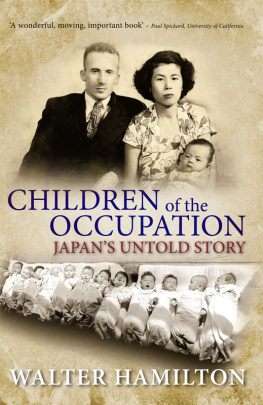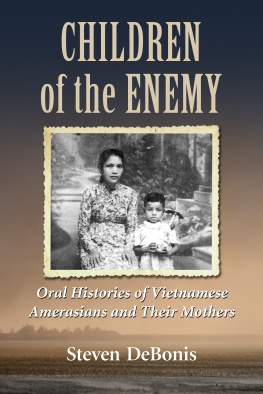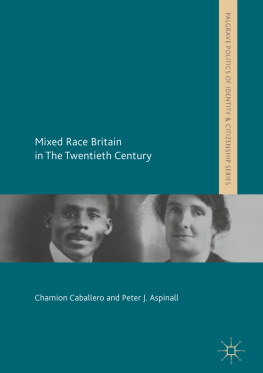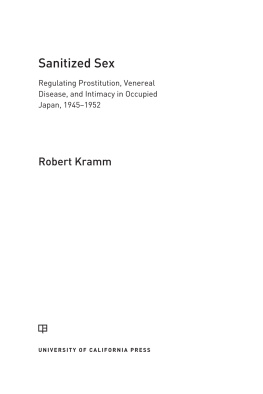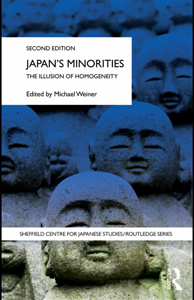CHILDREN of the
OCCUPATION
WALTER HAMILTON is a journalist with close to four decades of experience working for Australian Associated Press and the Australian Broadcasting Corporation in Sydney, Canberra, London, Singapore and Tokyo. He was Northeast Asia Correspondent for the ABC for a total of 11 years between 1979 and 1996. He covered civil strife and democratic change in South Korea, Taiwan, China and the Philippines; economic boom and bust in Japan; natural disasters, including the Kobe Earthquake; and man-made terrors, such as the Aum Shinrikyo sarin nerve gas attacks. He has published two books, Serendipity City: Australia, Japan and the Multifunction Polis (ABC Books) and Koala No Hon (with Hamish McDonald, for Simul Press).
CHILDREN of the
OCCUPATION
JAPANS UNTOLD STORY
WALTER HAMILTON

A NewSouth book
Published by
NewSouth Publishing
University of New South Wales Press Ltd
University of New South Wales
Sydney NSW 2052
AUSTRALIA
newsouthpublishing.com
Walter Hamilton 2012
First published 2012
10 9 8 7 6 5 4 3 2 1
This book is copyright. Apart from any fair dealing for the purpose of private study, research, criticism or review, as permitted under the Copyright Act, no part of this book may be reproduced by any process without written permission. Inquiries should be addressed to the publisher.
National Library of Australia Cataloguing-in-Publication entry
Author: Hamilton, Walter, 1952
Title: Children of the occupation: Japans untold story/Walter Hamilton.
ISBN: 9781742233314 (pbk.)
ISBN: 9781742243498 (Kindle)
ISBN: 9781742245298 (ePDF)
ISBN: 9781742241401 (ePub)
Notes: Includes bibliographical references and index.
Subjects: Racially mixed children Japan
Identity (Psychology) Social aspects Japan.
Military bases, American Japan Social aspects.
Japan History Allied occupation, 1945-1952.
Japan Social life and customs 1945
Dewey Number: 395.3
Design Josephine Pajor-Markus
Cover images A family portrait had to serve in place of a marriage certificate: Joe Ritchie with Sachiko and George Tsutsumi (Courtesy George Tsutsumi); Mixed-race orphans taken into care were not as numerous as they were made to appear. (Photograph by Ky Kageyama. Courtesy Tomohiro Kageyama.)
Back cover image Peter Budworth, at age 2, in Australian Army slouch hat and boots, Kure, 1956. (Source: George Budworth.)
Printer Griffin
All reasonable efforts were taken to obtain permission to use copyright material reproduced in this book, but in some cases copyright could not be traced. The author welcomes information in this regard.
This book is printed on paper using fibre supplied from plantation or sustainably managed forests.

The publisher gratefully acknowledges the support of The Japan Foundation, Sydney.
Contents
Preface
As I was about to depart Australia to take up my first posting as a correspondent in Japan, 33 years ago, a woman friend expressed the earnest hope that I would not go marrying some Chink (by which she meant any Asian). The fact I eventually did marry a Japanese is one reason for my undertaking this book. Another derives from my experience of living for a dozen years in a country where I could only ever be an outsider, a gaijin: physically conspicuous but socially invisible. I was shown many courtesies as I went about my work for the Australian Broadcasting Corporation; being allowed to be ordinary was not one of them.
If I felt caught between two opposing ideas of where I belonged, how much more difficult it must be, I thought, for someone made to feel they did not belong where they came from? This is what struck me most when I encountered the mixed-race offspring of the post-war occupation. They were Japanese in every other respect language, mentality and cultural orientation except the way they looked. In their case, they were given no choice as to where they should be or which allegiance to hold. Worse still, their origins were perceived, rightly or wrongly, to be low and immoral. I found myself drawn to their story.
On the 60th anniversary of the Japanese surrender, I made a short documentary for ABC-TVs Foreign Correspondent program, retracing the lives of several individuals fathered by Australian members of the occupation forces. The freckle-faced, fair-haired children so outstanding in films and photographs from the 1950s and 1960s were now grey-haired, settled members of society. Their poignant reminiscences spurred my desire to learn more to better understand not only Japanese attitudes to race mixing and the war but also why Australians of my own generation still spoke in terms of Chinks.
Through document searches and personal contacts, I assembled a casebook on 150 men and women born mainly in the city of Kure, in Hiroshima prefecture, which served from 1946 to 1952 as headquarters for the British Commonwealth Occupation Force. I call the mixed-race children left in this part of western Japan the Kure Kids. Their fathers were Australian, American, British, New Zealander or Indian. They stood out by their appearance and because so many were concentrated in one provincial area.
Unsurprisingly, when I began my research, many of the Kure Kids expressed reluctance to revisit unpleasant memories. In agreeing to be interviewed, they needed to find a way past lingering pain and resentment. It was a journey some declined to make, for their own sake or that of their families. Another challenge was tracking down those who had moved away to other parts of Japan or gone abroad. They had put a physical distance between themselves and the past; going back would entail a different kind of risk.
To satisfy both the historical and biographical aims of this book, I combine two styles of narrative. One tells the stories of selected individuals in their own words and through contemporary documents. The other chapters seek to position these lives within a richer context, by examining how attitudes to race mixing have evolved over the centuries and by tracing the impact of racial ideology on national policy and cultural identity in Australia, Japan and the United States.
Abbreviations
ABC | Australian Broadcasting Corporation |
ACC | Australian Council of Churches |
Advertiser | The Advertiser, Adelaide |
Age | The Age, Melbourne |
Argus | The Argus, Melbourne |
Asahi | Asahi Shimbun |
ASIO | Australian Security Intelligence Organisation |
AWM | Australian War Memorial, Canberra |
BCFK | British Commonwealth Forces Korea |
BCOF | British Commonwealth Occupation Force |
Chu N | Chugoku Nippo |
Chu S | Chugoku Shimbun |
CPD | Commonwealth Parliamentary Debates |
DoEA | Department of External Affairs |
GHQ | General Headquarters |
Herald |
Next page
